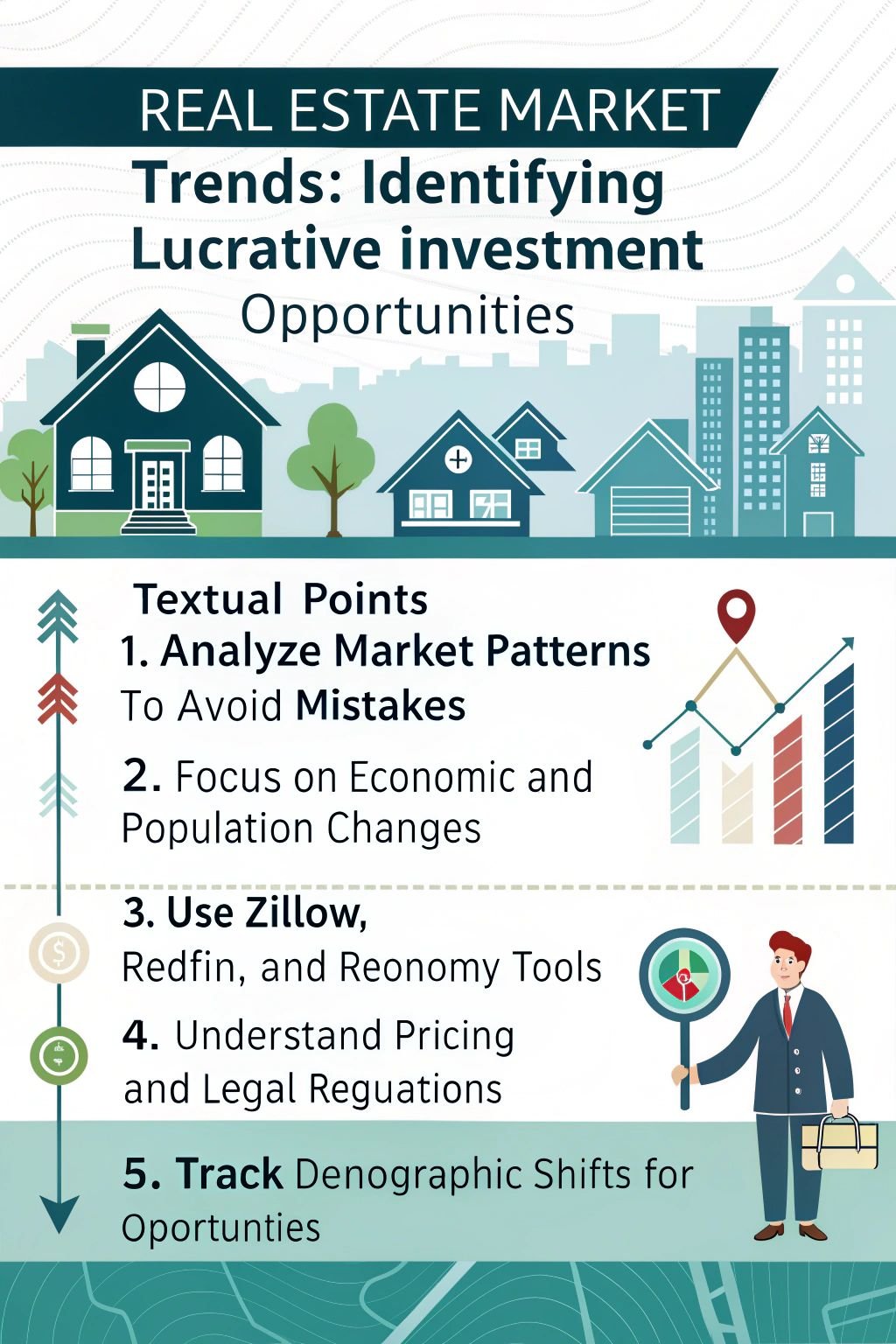Thinking about investing in real estate but not sure where to start? You’re not alone. Many people want to get involved in real estate but worry about making the wrong choice.
Real estate market analysis is key to finding the best deals. Did you know that understanding market trends can boost your investment success? 1 In this blog, you will learn how to spot the best opportunities and avoid common mistakes. 2 Get ready to make smart moves in the real estate market! 3
Key Takeaways
- Analyzing the real estate market helps you find the best deals and avoid mistakes.
- Key factors include economic indicators, population changes, and supply and demand.
- Use online tools like Zillow, Redfin, and Reonomy to get important market data.
- Understand property prices and legal rules to make smart and safe investments.
- Changes in demographics, such as more millennials and retiring baby boomers, create new opportunities.

Understanding Real Estate Market Analysis

Thinking about investing in real estate? Mastering market analysis—like reading housing data and property prices—can help you avoid rookie mistakes.
Definition and Importance
Real estate market analysis checks the potential of investing or renting properties in specific areas. It looks at property values, supply and demand, and local market trends. A comparative market analysis estimates what a property is worth, helping you decide to buy, sell, or lease.
This type of market research is essential for real estate investing and managing property rights effectively. 1
Understanding real estate market analysis helps reduce risks and find profitable opportunities. By analyzing housing data and demographic shifts, you can make smarter investment choices.
Knowing national and local trends boosts your return on investment (ROI). Whether you’re a homeowner, investor, or real estate agent, effective market analysis guides your decisions and enhances your strategy.
Informed decisions lead to successful investments. 1
Key Components of Market Analysis
Understanding the key parts of market analysis helps you make smart real estate decisions. First, look at economic indicators like interest rates and job growth. These factors affect property values and demand. 2 Next, examine demographic trends such as population growth and age distribution. Knowing who is moving into an area can guide your investment choices.
Supply and demand play a big role too. Check how many homes are for sale versus how many people want to buy. This balance impacts prices and rental rates. Don’t forget to study the competition.
See what other real estate agents and investors are doing. This information helps you set the right prices and find your niche in the market.
Lastly, consider legal and environmental factors. Make sure you understand local regulations and property rights. This ensures your investment is safe and complies with laws. Using online databases and talking to local experts can give you accurate market research.
These components together make a strong foundation for your real estate market analysis.
Steps for Conducting an Effective Real Estate Market Analysis

To start your market analysis, quickly scan current trends to spot where the market is headed. Next, dig deep into supply and demand to see which areas are booming and where prices are just right.
Initial Screening of Market Trends
Start by looking at local market trends, property values, and rental rates. Check demographic shifts to see who is moving into the area. Use the Housing Price Index (HPI) to track changes in real estate market trends.
Examine housing starts, permits, and sales data to understand supply and demand. Median home prices give you a clear picture of the market. 2
Next, review economic indicators like job growth and unemployment rates. These factors affect real estate investments. Utilize online platforms and reliable housing data sources for accurate information.
Consulting local real estate agents can provide insights into the competitive landscape. This initial screening helps you identify lucrative investment opportunities.
Understanding market trends is the first step to successful real estate investments.
In-depth Analysis of Supply and Demand
Moving forward, let’s dive deeper into supply and demand. Spotting markets with the right balance can set you up for success. 3 Look at property values and rental rates to gauge if demand is strong.
Check out demographic shifts too—are more families moving into the area?
On the supply side, see who your competitors are and their share of the market. More competitors might mean tougher pricing, while fewer can offer better opportunities. Understanding these dynamics helps you set the right property prices.
Don’t forget to consider legal and environmental factors. New regulations or laws can impact your investment, so stay informed to make smart choices.
Evaluation of Property Pricing
Analyzing property prices helps you make smart real estate decisions. Start by comparing similar homes in your area. Look at recent sales and current listings in Washington, D.C., or nearby neighborhoods.
This comparative price analysis shows you what buyers are willing to pay and helps set a fair price for your property. 4
Supply and demand play a big role in property pricing. If more people want homes than there are available, prices go up. Keep an eye on housing data and economic conditions like interest rates.
Tools like market research platforms and comparative market analysis tools make it easier to assess these factors. Understanding these elements helps you evaluate property pricing trends effectively and make informed decisions as a homeowner, real estate agent, or investor.
Legal and Environmental Considerations
After assessing property prices, it’s crucial to examine legal and environmental factors.6 Check title documents to ensure there are no ownership issues.5 Land use permissions tell you what you can and cannot do with the property.
Knowing zoning laws and tax regulations helps keep your investment on solid ground. 5
Environmental studies are equally important. They reveal any potential issues like soil contamination or flood risks. Complying with local regulations avoids fines and boosts your property’s value.
Staying aware of these legal and environmental aspects makes your real estate investment safer and more profitable.
Emerging Opportunities in Real Estate

With shifts in demographics and the economy, you can find amazing investment opportunities in real estate – keep reading to learn more!
Demographic Shifts Impacting Property Values
Demographic trends play a big role in housing demand and property values. As the population grows, more homes are needed. Millennials are looking for starter homes and enjoy living in cities.
This increases demand for urban real estate and affects market values. 7
Baby boomers are retiring, which means there’s a higher need for downsizing options and senior living communities. This shift changes the types of properties that are valuable. Gentrification from these demographic changes can refresh neighborhoods, making them more appealing.
By studying demographic data and real estate market trends, you can find areas with growth potential and make smart investment choices.
Investors should keep an eye on these changes. Understanding who is moving into an area and what they need helps in evaluating property pricing. Market research tools and membership resources from organizations like nar.realtor can provide the information you need.
Use this knowledge to identify lucrative opportunities and manage risks effectively.
Economic Indicators and Their Effects on Real Estate
Economic indicators have a big impact on real estate. High employment rates mean more people can buy homes. When jobs are steady, homeowners feel secure and are more likely to invest in property.
Positive GDP growth also creates a great environment for real estate investments. Investors see a growing economy and are eager to put their money into commercial and residential real estate.
Consumer confidence plays a key role too. When people feel good about their finances, they are more likely to purchase homes, which boosts property values. Look at housing data like housing starts and building permits.
An increase in these numbers shows that the economy is strong and growing. 8 Real estate investors should monitor these trends to find the best opportunities. Keeping an eye on employment trends in important sectors helps you make smart decisions for your investments.
Next, let’s explore the steps you can take to conduct an effective real estate market analysis.
Financing Real Estate Investments
 Financing real estate investments goes beyond using your own money. Debt from credit markets is essential for making big purchases. 9 Hard money loans are a great option when you need funds quickly for buying or renovating properties. 10 In competitive markets, having fast financing can help you secure the best deals before others do. By evaluating different financing options, you can maximize your returns and choose the best path for your investments.
Financing real estate investments goes beyond using your own money. Debt from credit markets is essential for making big purchases. 9 Hard money loans are a great option when you need funds quickly for buying or renovating properties. 10 In competitive markets, having fast financing can help you secure the best deals before others do. By evaluating different financing options, you can maximize your returns and choose the best path for your investments.
Strategic financing supports your current projects and also helps you reach your long-term investment goals.
Choosing the right financing can make a big difference in your success. Whether you’re a homeowner, real estate agent, or investor, understanding your options is key. From traditional loans to private equity, each choice has its benefits.
This knowledge sets you up for smart decisions and profitable investments. Up next, explore the top tools and resources that can help you research the real estate market effectively.
Top Tools and Resources for Real Estate Market Research

Explore top websites and databases to access the latest housing data and real estate trends. Use market research tools to uncover the best investment opportunities and stay ahead in the game.
Online Platforms and Statistical Databases
Online platforms give you essential tools for real estate market analysis. Redfin provides valuable data and easy-to-use tools for investors like you. 11 Zillow Research offers the Zillow Home Value Index (ZHVI), which shows how property values change over time.
Reonomy uses machine learning to deliver detailed data on commercial real estate, helping you make informed decisions.
Statistical databases enhance your market research efforts. RealtyTrac specializes in foreclosure properties and offers comprehensive market trend reports. CoreLogic covers 98% of Australia’s housing market with extensive data, giving you a broad view of real estate trends.
These platforms use predictive analytics to forecast market movements, so you can stay ahead of the competition. Explore these resources to better understand market trends and identify lucrative investment opportunities.
Comparative Market Analysis ToolsComparative Market Analysis tools help you find accurate property values. New Silver’s ARV Calculator is great for estimating after-repair values. 12 MLS provides comprehensive data on listing prices and recent sales.
Mashvisor offers detailed insights into both residential and commercial real estate. These tools give you the numbers you need to make smart investments.
Zillow is another useful tool, offering free services to find comparable properties in your area. 12 Real estate agents can also provide detailed CMAs, especially helpful for new investors.
Accurate and timely market data is essential. 13 Choose tools with user-friendly interfaces and customizable analytics to fit your needs. With the right CMA tool, you can confidently evaluate property prices and spot the best investment opportunities.
How Market Analysis Influences Real Estate Investment

Understanding market trends helps you find the best investment deals. Using tools like comparative market analysis, you can handle risks and plan smart moves.
Identifying Lucrative Investment Opportunities
Spotting great investment chances starts with a solid real estate market analysis. You need to check housing data and demographic trends to see where values are rising. Look at supply and demand in areas you’re interested in.
High demand with low supply often means better returns. Use online platforms and statistical databases to gather your information quickly. Knowing the local zoning laws and tax rules helps you avoid surprises and plan better. 2
Keep an eye on economic indicators like job growth and income levels in Washington, D.C., or other key markets. These factors can boost property prices and create more opportunities for landlords and real estate agents.
By using market research tools, you can compare different neighborhoods and find the best spots for investment. This approach minimizes risks and helps you make smart choices that maximize your profits. 14Risk Management and Strategic Planning
Finding great investment opportunities is just the first step. Managing risks and planning strategically ensures your investments thrive. Analyzing market dynamics and economic factors can help you avoid potential pitfalls.
By understanding real estate market analysis, you can make smarter decisions that protect your investments. 14
Professional guidance plays a key role in interpreting market data. Experts can help you align your investment plan with current market trends. Keep an eye on housing data and demographic shifts to adjust your strategies as needed.
Diversifying across different property types, like residential and commercial real estate, can also enhance your portfolio’s success.
Staying updated with industry trends ensures you’re always ready to adapt. Continuous monitoring allows you to respond quickly to changes in the market. This proactive approach to risk management and strategic planning safeguards your investments while also positioning you for long-term growth.
Conclusion

Keep an eye on real estate trends to find great investment opportunities. Use online tools and housing data to guide your decisions. Understanding the market helps you pick the right properties and avoid risks.
Act now to make the most of these chances. Your smart choices today can lead to big rewards tomorrow.
FAQs
1. What are the current real estate market trends I should watch for?
Right now, real estate market trends show a mix of booming residential areas and steady commercial real estate growth. Keeping an eye on housing data and demographic data helps you spot where the next big investment opportunities are. Plus, international real estate is gaining traction, so don’t miss out!
2. How can market research help me find lucrative investment opportunities?
Market research is your best friend! It helps you understand real estate market analysis, industry trends, and market shares. By diving into feasibility studies and inventory data, you can identify which properties have the best potential for job creation and profit. Plus, tools like digital marketing can give you a competitive advantage.
3. What role do advocacy organizations play in real estate investment?
Advocacy organizations support real estate agents and brokers with resources like real estate training and NAR member information. They help you stay updated on property rights and industry trends. Joining these groups can boost your membership value and keep you ahead in the market.
4. How important is property management in real estate investment?
Property management is crucial! Good management keeps your tenants happy and your expenses low. It involves everything from leasing to handling property rights. Plus, effective property management can increase your market shares and ensure your investments remain profitable.
5. Can digital marketing tools like Amazon Prime and Kindle help in real estate?
Absolutely! Digital marketing tools like Amazon Prime and Kindle can help you reach more potential buyers and investors. Using platforms like Prime Video for virtual tours or Kindle for real estate guides makes your listings stand out. Plus, integrating credit card checkout options can simplify transactions.
6. What should I include in a feasibility study for a real estate investment?
A solid feasibility study covers market research, housing data, and demographic data. It looks at expenses, potential market shares, and competitive advantages. Don’t forget to analyze leasing options and inventory levels. This study helps you decide if the investment is right for you and ensures you’re making a smart move.
References
- ^ https://passby.com/blog/real-estate-market-analysis/ (2024-04-16)
- ^ https://www.mayfairpropertymanagement.com/blog/how-to-conduct-effective-market-analysis-real-estate-investments
- ^ https://fastercapital.com/content/Real-estate-market-analysis–How-to-Conduct-a-Real-Estate-Market-Analysis-and-Identify-the-Best-Markets-to-Invest-In.html
- ^ https://www.netquest.com/en/blog/how-to-conduct-real-estate-market-study-perfect-guide (2024-10-21)
- ^ https://www.proven.partners/blog/real-estate-market-analysis
- ^ https://www.linkedin.com/pulse/mastering-real-estate-market-analysis-essential-tips-md-ccrp-68gaf
- ^ https://www.har.com/blog_115027_demographic-trends-shaping-the-real-estate-market
- ^ https://www.ownitdetroit.com/blog/the-role-of-economic-indicators-in-real-estate-investment
- ^ https://kth.diva-portal.org/smash/get/diva2:1874433/FULLTEXT01.pdf
- ^ https://www.linkedin.com/pulse/how-analyze-real-estate-markets-investment-jeff-fechter-jbz3c
- ^ https://est8r.com/10-real-estate-market-data-platforms-for-investors/ (2024-01-31)
- ^ https://newsilver.com/the-lender/real-estate-market-analysis-tools/ (2024-01-25)
- ^ https://surveysparrow.com/blog/real-estate-market-analysis-tools/ (2024-07-19)
- ^ https://www.linkedin.com/pulse/how-analyze-real-estate-market-trends-investment-sage-bs-cm-ms-xrcm-pfkwc





















